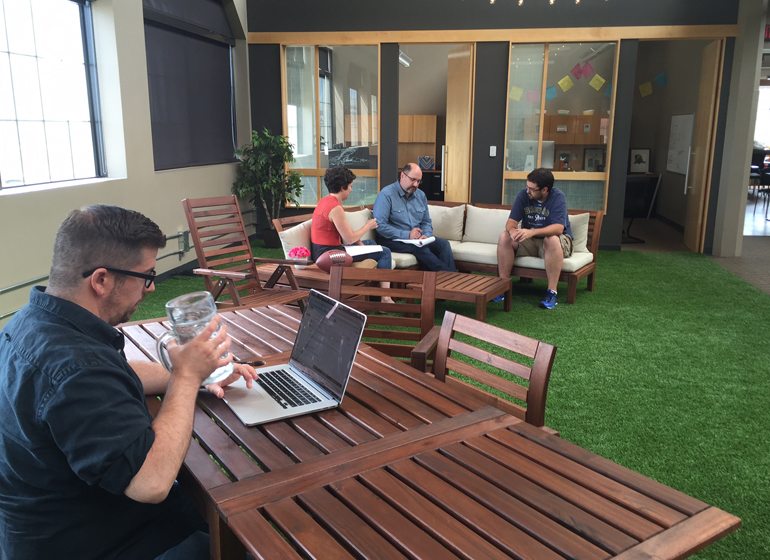For roughly eight months, employees at Core Creative Inc. in Milwaukee’s Walker’s Point neighborhood have been settling into a new office configuration meant to encourage collaboration and creativity.
The advertising agency, which occupied the top floor of a seven-story building in The Tannery complex, expanded into the floor below and freed up space for open concept meeting rooms.
Four major collaborative spaces were added, each with its own nickname.
There’s “The Can,” a round conference room on the sixth floor with whiteboard walls and a monitor; “The Yard,” a lounge-like area of patio furniture set up on a patch of artificial grass on the seventh floor; “The Cantina,” a modern office kitchen; and “The Half Moon,” an open concept, semi-formal meeting room with a large semicircular table.
So far, Core Creative partner and vice president of design services Jeff Speech said the changes have led to what he described as a “buzz” around the office.
“With fewer barriers, you’re suddenly a part of something and it just creates energy,” Speech said. “There’s a good buzz. People like being around it.”
Employees have begun gravitating toward the spaces with laptops, he said, and even freelancers the company has hired to do project work have been spotted coming in to the office to feed off the collaborative energy.
“It’s a balance,” he said. “The style for a while was to be wide open and have long tables. That kind of thing, the trends are showing that’s maybe a little too open.
Some people just don’t like working that way. We found wide open isn’t the way to do it. It’s kind of a balance for us: Everybody has some walls, but they’re not closed-off entirely. My advice would also be to ask your employees what they like and dislike. It goes a long way.”
A survey completed in 2015 by Knoll Inc., a design firm that also manufactures office furniture, found modern offices are faced with a specific challenge: balancing physical space for employees with the increasingly important mobile workplace. Adding to the challenge is an increased emphasis on creative, knowledge-based work that is less process-driven and more spontaneous.
“Facilities managers queried for this investigation explained that one of their greatest challenges in meeting these new demands is to continue providing enough space for desk-based work without damaging flexibility by requiring staff to book space ahead of time,” the report reads.
The report cited a growing demand for both quiet work spaces that allowed employees to concentrate or make conference calls, and multi-purpose cafés and outdoor spaces for informal meetings and collaborative interactions.
Though that may seem contradictory, some companies, such as ManpowerGroup, have found ways to make it work.
Manpower’s global headquarters in downtown Milwaukee was built in 2007 and has an open design that floods the workplace with natural light. While each employee does have a partially walled-off, cubicle-like desk space, there are also rooms with pingpong tables and whiteboard walls.
Brightly colored booths are scattered throughout the space to break up the usual office monotony and a full-service café and cafeteria on the first floor overlooking the Milwaukee River is a popular meeting place for employees.
Because of the company’s wide global presence, its collaborative rooms, such as its “Connection Point” space on the first floor, are outfitted with large screens set up for video conferences with colleagues around the world.
“This is how you make a global company work virtually,” said ManpowerGroup spokesperson Alec Wescott on a recent morning, while a fellow employee spoke to a colleague using Connection Point’s video chat monitors. “We have calls all the time here with people all over the world. The Connection Point itself … It really is emblematic of the environment we’re trying to create. It is digital, it is contemporary, it is inviting. The whole wall is a whiteboard for brainstorming.”
Milwaukee Tool’s open concept atrium at its Brookfield headquarters is another example of a collaborative hub used to complement private work environments, rather than replace them.
“We believe flexibility is incredibly important in a space like this, so we equipped the area with a wide range of furniture that caters to our employees’ immediate needs, such as mobile monitors and whiteboards, and moveable chairs and tables,” said Steve Richman, group president for Milwaukee Tool. “We are constantly evaluating how our employees like to work, how they’re collaborating, and how we can best create spaces like this to continue to inspire and drive disruptive innovation.”
Bonus online content: View a photo gallery of unique Milwaukee-area office spaces at www.biztimes.com/gallery/metro-milwaukee-office-spaces.








